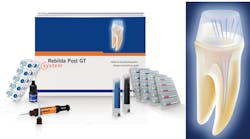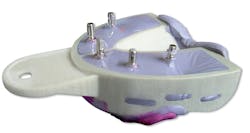Pearls For Your Practice: Impression trays, universal composite
Miratray Implant Advanced impression trays by Hager Worldwide
Restoring implants seems like it would be an incredibly easy proposition. There’s no tooth to prep, no finish line to refine. Generally, there is no anesthetic to inject or cord to pack. Once the implant is integrated, we simply need to accurately impress the implant so the lab can make a beautiful restoration. Sounds simple, right?
Unfortunately, we do have some key decisions to make when it comes to that ever-important impression. One of the most important choices is whether to make an open-tray or closed-tray impression. Closed-tray impressions are somewhat simpler, but they can be less accurate than open-tray impressions.1
Open-tray impressions, while more accurate, are cumbersome. The biggest pain point of the process is the tray. We have to fabricate some kind of tray to take an open-tray impression. That might be a true custom impression tray, which generates a lab fee. It could also be a stock tray that has been modified in the laboratory, which generates a mess and sucks time. Neither option is great. That is why most clinicians choose a closed-tray impression technique, despite it being less accurate. Miratray Implant Advanced impression trays from Hager Worldwide can help ease the biggest pain point of an open-tray implant impression—the tray!
Miratray Implant Advanced impression trays come in three different sizes for each arch. They look like traditional plastic impression trays, except on the occlusal surface. The occlusal surface is covered with a clear foil that is pierced by the open-tray impression coping as you place the impression in the mouth. The copings cleanly pierce the clear foil, so four pounds of excess impression material won’t spew out of massive holes in the tray. It is faster, neater, and easier than trying to MacGyver your stock trays to take an open-tray implant impression.
Other than the clear, pierceable foil on the occlusal surface, the trays work identically to any other stock plastic trays. You will still need to use polyvinyl siloxane (PVS) or polyether adhesive on them, so don’t forget that important step.
A neat, clean open implant impression tray that is always ready to go is a really nice addition to your armamentarium. These have saved me time from having to make my own custom trays and have saved me money from having to order custom trays from the lab. They have made it easier and simpler to take an open-tray implant impression, and I love that! Hard-hit base hit up the middle for Hager Worldwide!
Reference
1. Kwon JH, Son YH, Han CH, Kim S. Accuracy of implant impressions without impression copings: a three-dimensional analysis. J Prosthet Dent. 2011;105(6):367-373.
Some choices are very deep and personal: The Beatles or Rolling Stones? Crunchy or smooth peanut butter? Oprah or Ellen? Coke or Pepsi? And probably most importantly, high- or low-viscosity composite? It may seem silly, but which composite a dentist uses is a very personal, intimate choice.
We develop long-term relationships with our composites of choice. Our composites are stalwarts in our day-to-day work lives. I probably spend more time with my composite of choice than I do with my family during the week, as sad as that sounds.
Your personal preferences drive which material you choose. If a particular brand of composite doesn’t match your preferences, that composite is dead to you. TPH Spectra ST from Dentsply Sirona aims to give you choices where most composites don’t and to simplify where other composites complicate.
TPH Spectra ST is a universal composite that gives you a choice in viscosities. Both a high viscosity and a low viscosity are available. I’m complex. Personally, I like a high-viscosity composite in Class IV situations. The high viscosity lets me shape and mold the resin to minimize shaping and finishing.
For Class II situations, I like a low-viscosity composite. I want to make sure I can get all the little nooks and crannies of the box filled in with no voids. I may do some mild occlusal anatomy shaping with instruments, but occlusal anatomy doesn’t matter if there is a big void in the box.
Having two different viscosities gives me options for different situations. You may prefer one viscosity over another. That’s the beautiful part of TPH Spectra ST—you have the choice!
The idea of a big master kit, chock-full of shades of two different viscosities of composite, blows my mind. I can barely manage one of those big master kits. It seems like we are always out of one of the shades, and another shade may be expired. It can be a chore to manage. That is where TPH Spectra ST’s Cloud shading comes in.
Cloud shading may sound like something you would do when painting a landscape with Bob Ross, but it’s much more fun than that. The chameleon effect of TPH Spectra ST simplifies shading, making one shade of composite match multiple Vita shades. Cloud shade A1 matches Vita A1, B1, and C1. Cloud shade A2 matches Vita A2, B2, and D2. Cloud shade A3 matches Vita A3, C2, D3, and D4. Cloud shade A3.5 matches Vita A3.5, B3, B4, and C3. Finally, Cloud shade A4 matches Vita A4 and C4.
Five shades can match an entire Vita Classic shade guide. I didn’t believe it at first, but after using the same shade of TPH Spectra ST on consecutive patients with different shades of teeth (verified with the Vita Easyshade V) and getting a great shade match on each, I was sold. TPH Spectra ST can simplify your restorative workflow by consolidating that big master shade kit. Unfortunately, this material does not have varying opacities, but you can get a great match in most situations without layering.
SphereTEC filler technology sets TPH Spectra ST apart from previous versions of TPH Spectra. This is Dentsply Sirona’s proprietary method of manufacturing spherical superstructures made of submicron glass, and it gives TPH Spectra ST its optimized handling, chameleon effect, and improved durability. I love the idea of having multiple viscosity choices and worrying less about picking the perfect shade because of the Cloud shade system. Finding a material that offers both flexibility and simplicity is rare. Deep fly-ball triple to center field for TPH Spectra ST by Dentsply Sirona!
About the Author
Joshua Austin, DDS, MAGD
Joshua Austin, DDS, MAGD, is a graduate and former faculty member of the University of Texas Health Science Center at San Antonio School of Dentistry. Author of Dental Economics’ Pearls for Your Practice column, Dr. Austin lectures nationally on products, dental technology, online reputation management, and social media. He maintains a full-time restorative dentistry private practice in San Antonio, Texas. You may contact Dr. Austin at [email protected].
Updated June 21, 2023



